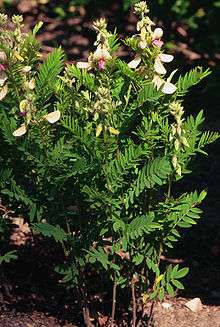Tephrosia virginiana
| Tephrosia virginiana | |
|---|---|
 | |
| Scientific classification | |
| Kingdom: | Plantae |
| (unranked): | Angiosperms |
| (unranked): | Eudicots |
| (unranked): | Rosids |
| Order: | Fabales |
| Family: | Fabaceae |
| Subfamily: | Papilionoideae |
| Genus: | Tephrosia |
| Species: | T. virginiana |
| Binomial name | |
| Tephrosia virginiana (L.) Pers. | |
| Synonyms[1] | |
| |
Tephrosia virginiana, also known as goat-rue, goat's rue,[2] catgut,[2] rabbit pea,[2] and Virginia tephrosia,[2] is a perennial dicot in family Fabaceae. This subshrub has alternate compound leaves. Its leaves are imparipinnate, with relatively wide pinnae. All parts of the plant are pubescent giving it a silvery, hoary appearance. The terminal, compact racemes of cream and deep pink flowers bloom May to August. This plant prefers acidic soils, in part to full sun. It grows throughout the Midwest, New England and southeastern United States.[3] Not easy to propagate, this plant can be found in sand savannas, open woods and glades, prairies and rocky soils. All tissues of this plant are toxic, and should not be eaten by people or livestock. Crushed stems were previously used as a fish poison.
References
- ↑ "The Plant List: A Working List of All Plant Species". Retrieved 26 July 2014.
- 1 2 3 4 "USDA GRIN Taxonomy".
- ↑ USDA Plants Database
- Peterson, Lee. (1977) A Field Guide to Edible Wild Plants of Eastern and Central North America. Houghton Mifflin Company, Boston. p. 82.